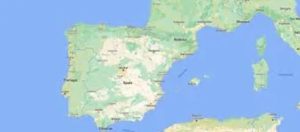 You’ve probably studied this map many times whilst considering your move … where is the best place to live geographically, to live among other expats or embrace a fully Spanish community, live close to the sea or inland, things to do close by, the climate in each area of Spain, and if you’re a DIYer how easy is it to source materials and tools in the area you’re thinking of moving to … the list goes on.
You’ve probably studied this map many times whilst considering your move … where is the best place to live geographically, to live among other expats or embrace a fully Spanish community, live close to the sea or inland, things to do close by, the climate in each area of Spain, and if you’re a DIYer how easy is it to source materials and tools in the area you’re thinking of moving to … the list goes on.
When I consider the information that was to hand 18 years ago when we made the move as a family of four, there is no comparison to the information readily available now! With forums and Facebook groups there is a large amount of information available at your fingertips; the internet has made the move much easier … or has it …? Online forums and fb groups where everyone becomes an expert, whilst useful, unfortunately can also lead to mis information and confusion and an inability to understand what you should or shouldn’t do.
So, in an attempt to keep things simple and assist you in your decision making I detail below a few pointers I’ve taken from individual articles I’ve written on each subject to help guide you not just from my personal experience, but from 18 years of working in Spain as a Chartered Financial Planner guiding expats on how to become tax efficient whilst living in Spain, whilst making sure you don’t unwittingly leave your loved ones exposed to an unnecessary inheritance tax bill and stress in the event of your death.
What to Consider when planning the move
The tax year (in Spain it runs from January to December not April to April). This may have an impact on your finances when making the move initially, dependant on how your income is made up and may require careful planning to avoid paying too much tax.
Selling your new home
 When you become a resident of Spain, your Spanish address becomes your home address, and by default any other property becomes a second home/holiday home and capital gains tax becomes payable on the profit made on the sale of that second home, with no ‘time apportionment’ relief (ie; no reduction in the tax payable even though you may have actually lived in that home for many years as your main residence prior to moving to Spain).
When you become a resident of Spain, your Spanish address becomes your home address, and by default any other property becomes a second home/holiday home and capital gains tax becomes payable on the profit made on the sale of that second home, with no ‘time apportionment’ relief (ie; no reduction in the tax payable even though you may have actually lived in that home for many years as your main residence prior to moving to Spain).
Capital gains tax is payable to the Hacienda at 19% on the first €6,000 profit, 21% on the next €44,000, 23% on the next €150,000 and 26% on the remainder.
It is considerably more advantageous to sell your property outside of Spain before you are deemed Spanish tax resident. To me it makes sense to keep the move as clean and simple as possible in respect of the Hacienda and avoid selling in the calendar year that your residency starts if possible. Technically speaking, if your residency starts on 1 September you have lived in Spain for less than six months that tax year, so you SHOULD be able to sell your home outside of Spain in that year without paying capital gains tax in Spain. However, if you want to ensure that the sale is not questionable in any way, it would be prudent to sell it in the calendar year before you make the move – remember, the tax year in Spain runs from 1 January to 31 December. Selling your main home in a separate tax year keeps it totally out of the equation with no issues.
Savings
 Let’s talk about your savings, because what’s tax efficient in one country is not necessarily tax efficient in another:
Let’s talk about your savings, because what’s tax efficient in one country is not necessarily tax efficient in another:
– ISAs (ISAs are not tax efficient in Spain). Any growth on an ISA as a Spanish resident must be declared on your Spanish Tax Return, whether you withdraw the growth or not! The growth is added to your income for the year.
There are alternatives available to you as a Spanish resident that are very tax efficient, with no tax paid on the growth each year along with other benefits, such as no Spanish Inheritance Tax payable on first death. Spain does not automatically offer the free transfer of assets between spouses on death so it is important that you do not leave yourself or your loved one unnecessarily exposed.
– Any other investments and savings held outside Spain that are not specifically Spanish Compliant (there are a number of issues here but I’ll try to cover the main ones). If these assets have a value of over €50k euros per person you will need to complete a Modelo 720. The information on the Modelo 720 is typically used to assess your assets for Spanish Inheritance Tax on death. As with ISAs, any growth achieved on your savings and investments as a Spanish resident must be declared on your Spanish Tax Return, whether you withdraw the growth or not! The growth is added to your income for the year. As mentioned above, there are alternatives available to you as a Spanish resident that are very tax efficient, with no tax paid on the growth each year along with other benefits, such as no Spanish Inheritance Tax payable on first death.
– Bank Accounts Outside Spain (your bank may ask you to close your account). Since BREXIT some banks do not have a license to operate in Spain. Other issues include a worldwide requirement for financial institutions to share information, called the Common Reporting Standard. I recommend you take advice in respect of your bank accounts as once a year information will be shared with the Hacienda (the Spanish Tax Authority).
– Bank Accounts in Spain (keep the amount held in a Spanish bank account to a minimum). Something we never need to consider with our UK bank accounts but definitely need to be aware of with a Spanish bank account, is that there are circumstances when should the Hacienda believe you owe money, or should you not pay a speeding fine for example, they are legally allowed to ‘embargo’ (take money) directly from your Spanish bank account. The onus is on you to demonstrate to them why they should not have done so rather than on the Hacienda to explain why they were right to do so – beware!
Making a UK and Spanish Will (make a Will in each country but make sure that one does not cancel the other).
 This is a complex area, but broadly if you die without making a Will in Spain your assets will be dealt with under Spanish forced heirship Law. This means that your spouse will not inherit your estate outright, as in Spain children must be included in set percentages. Your spouse may have a right to live in the property that you own until their death, but they will not automatically inherit your share.
This is a complex area, but broadly if you die without making a Will in Spain your assets will be dealt with under Spanish forced heirship Law. This means that your spouse will not inherit your estate outright, as in Spain children must be included in set percentages. Your spouse may have a right to live in the property that you own until their death, but they will not automatically inherit your share.
Your UK Pensions (any pension other than the UK State Pension)
 – Your Pension Commencement Lump Sum
– Your Pension Commencement Lump Sum
Known by many expats as their ‘25% tax-free cash’, whilst tax free when living in the UK, it is not tax free when living in Spain. 60% of any pension commencement lump sum is taxed as income for that year when you are Spanish tax resident (irrespective of the type of pension) … so the timing when taking any 25% pension commencement lump sum (PCLS) is crucial. If you are thinking about taking your tax-free cash, and are also moving to Spain, it may be worth considering, if appropriate, to take the 25% before becoming tax resident of Spain.
– Income from your UK Pensions
Initially when taking income from your UK pension you will be given an emergency tax code by HMRC, which will later be adjusted, with income from any UK pension scheme normally taxed under Pay As You Earn guidelines (PAYE) in the UK. As a Spanish resident, the pension income should then be added to your Spanish tax return, the appropriate tax paid and you will need to reclaim the tax paid in the UK under PAYE from HMRC.
By comparison, you could consider a move to an overseas pension scheme, called a QROPS. From a QROPS, income (dependant on the jurisdiction) is paid gross. This makes life much simpler because you do not need to deal with different tax authorities.
The way QROPS income is reported in Spain is a grey area as the Spanish don’t really understand QROPS; so it’s down to each individual to decide how the income is reported. QROPS are ‘typically’ taxed as a five year temporary annuity, resulting in a marginal rate of 3% income tax. This offers fantastic tax planning opportunities for those living in Spain when compared to the tax paid under PAYE on UK pension scheme income!
– Death Benefits – Cliff edge at age 75!
This is the less known and yet very important issue. Where the deceased pension policyholder was age 75 or more at the date of death, their beneficiary (often their spouse or children) will pay their marginal rate of Income Tax on the pension income/lump sum paid out on death. This effectively creates a cliff edge at the age of 75 on a UK pensions after which the tax-free benefits are lost!
However, every cloud has a silver lining! From a QROPS, once you have been non-UK resident for five complete UK tax years, the whole fund can be passed free of UK tax, and in some circumstances can continue to run (thereby keeping the funds outside the estate, since the ultimate beneficiaries may be your children). This is a massive benefit when considering the ‘cliff edge’ mentioned above, where the payment of benefits tax-free ends with UK pension schemes on death from age 75.
This list is not exhaustive and each individual clients’ circumstances are different when it comes to providing financial advice that future proofs you as much as possible. As you can see, there’s a lot to think about, but by ensuring you have received the right advice for your own situation, you can make the move in a very tax efficient way!
The above contents and comments are entirely the views and words of the author. FEIFA is not responsible for any action taken, or inaction, by anyone or any entity, because of reading this article. It is for guidance only and relevant professional advice should always be taken before investing in any assets or undertaking any financial planning.
